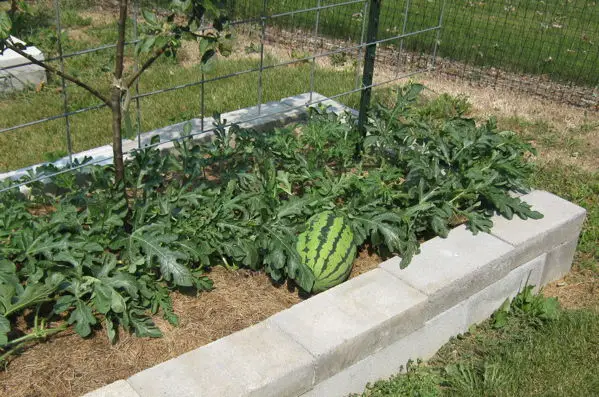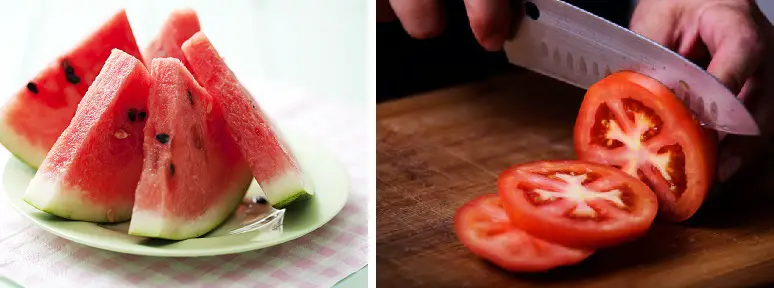Sunscreen is seen as a necessity in today’s society, going by what TV reporters and news articles have to say on the subject.
But what most people don’t realize is that sunscreens are usually loaded with toxic chemicals that can clog up pores, seep into the bloodstream, and pollute your body on a level not seen with other personal care products.
Making matters worse is the tendency for most people to slather it all over their bodies in a misguided attempt to prevent any sun from reaching them.
While sunscreen is a health risk, diet does matter for protecting your health from the negative effects of the sun, and the best place to start is with a pair of humble fruits that most people would never dream of using for such a purpose.
These Two Fruits Give Sun Blocking Benefits

Tomatoes and watermelons have one thing in common for human skin from the sun: both contain lycopene, the prostate-supporting substance known for its ability to help prevent prostate cancer.
Lycopene has a remarkable property that is impossible for even the most determined scientists to replicate: it helps to absorb both UVA and UVB radiation, according to a 2012 study published in The American Journal of Clinical Nutrition (see here).
That’s an important distinction to make because both types could seriously harm your skin.
The Difference Between UVA and UVB Radiation

Both forms of radiation can be harmful, as mentioned previously, but UVA radiation is far more common.
It makes up 95% of all of the UV rays that reach the Earth’s surface, according to a report from the MD Anderson Cancer Center at the University of Texas.
This type of radiation penetrates deep into the skin and may cause damage, typically resulting in a tan.
It is the main form of radiation used in tanning beds, and causes almost all forms of skin aging, including wrinkles. It also damages the collagen and elastin in the skin.
***
Editor’s note: You may want to try using a red light therapy device like this one to help reverse sun damage, and to give your body the ability to replenish its healthy natural collagen stores over time.
This is the one I do my best to use every morning.
***
Needless to say, UVA radiation is a huge threat to the health and appearance of your skin, which is why sunscreens are so popular.
When UVA “partners up with UVB,” the second type of radiation given off by the sun, it can lead to more serious problems such as skin cancer, according to Dr. Saira George, a dermatologist at the Center.
Aside from UVA radiation, UVB radiation is also a potential threat to skin and overall health when exposing yourself to high levels over long periods of time.
This latter form of radiation only makes up 5% of the UV rays, but it is very high energy and can wreak havoc on the top layer of the skin, according to Dr. George.
It can also lead to cataracts and cause DNA mutations leading to skin cancer — not something you want to expose yourself to long-term!
How to Protect Yourself from the Sun Using Watermelon, Tomatoes

While watermelons and tomatoes aren’t a catch-all solution to the radiation problem, the lycopene contained within does have the ability to bestow a certain level of protection against the sun on the user.
Tomatoes produce more lycopene when cooked, although they have less than watermelon and don’t provide the same hydrating and cooling effect.
The more lycopene you consume, the more your body can potentially utilize it to build up a health resistance, according to the aforementioned research.
After a few weeks of consistent watermelon consumption, the lycopene eventually starts congregating in the body and begins acting as a natural sunblock, according to the Journal of Clinical Nutrition.
Researchers added that it doesn’t necessarily take the place of sunscreen (if you do choose sunscreen, opt for a non-toxic, preferably organic brand like this one), but it can help you build up resistance to sun damage in the safest and healthiest way possible — without the side effects typically found in industrially produced sunscreen products.
Needless to say, watermelons and tomatoes were both given copious amounts of lycopene for a reason, and that’s just part of the reason why they are such beloved summer fruits.
If you have a chance to buy them organically or even grow them yourself, do not hesitate, especially if you live in an area where sun coverage is high and cooling off is not always the easiest thing to do.
You body (and your skin) will thank you.
Thank you for reading!
For more information on lycopene blocking the sun’s rays, check out this resource.
If you’re looking to absorb more healing energy from the sun (in a safe, non toxic way) to supercharge your immunity and natural Vitamin D production capabilities, begin browsing and learning more about the benefits of home-based Red Light Therapy devices by clicking here.
Thanks for installing the Bottom of every post plugin by Corey Salzano. Contact me if you need custom WordPress plugins or website design.




